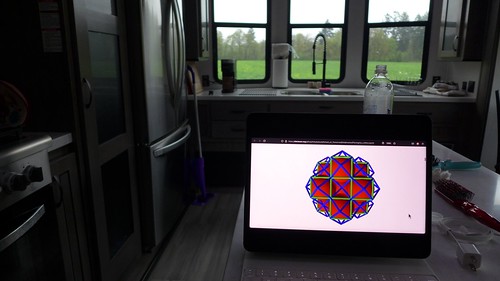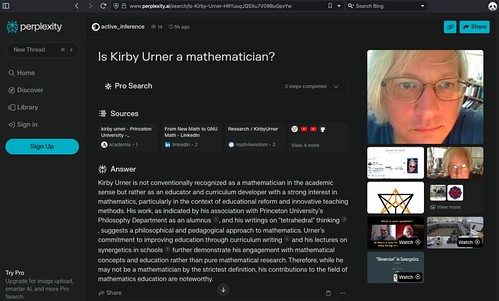Thursday, March 28, 2024
Tuesday, March 19, 2024
Meeting Notes
I was admiring the curriculum materials shaping up around ant colonies, their study. Daniel knows a lot about ants, and yet humanity on the whole still has a lot to learn. The study of ants is somewhat humbling, in terms of revealing our own ignorance.
Picture a queen ant, surrounded by layers of caretakers and apparent hangers on. We say "apparent" because in some theories the seeming passive crowds may store collective memories, ready to be expressed if triggered. The queen never ventures forth and workers tainted with experience of "the outside" don't get anywhere near her. If she serves a decision-making role (unclear) it's from within an abstracted layer where experience consists of pheromones.
Remembering that Andrius wants to "know everything" (the answer to the prayers of those with boundless curiosity), I'm eager to introduce him to CJ's work on comprehensivity. The commitment to "learn everything" is inherently problematic, and sounds like empty chutzpah unless qualified with self awareness and acknowledgement of the inherent paradoxes.
"Tackling it all" is not only possible, but what we all do every day. It's just that, depending upon strategy, resources, and the practice of specific disciplines, how much we accomplish towards our impossible goal varies by orders of magnitude.
I took some time this morning, after feeding the dog, adding to my M4W repo on Github, where I chronicle recent progress. I haven't expressed a "know everything" goal, but I do value "comprehensivity" as CJ calls it, as many of the levers one needs to discover, as an activist, come to light only through considerable experience. Those into ML (machine learning) have a lot of concrete mathematics to show why quantity, not just quality, matters.
As a Quaker journalist, i.e. blogger, I need to keep twisting my strands together, and pulling tight, making a strong alloy, the way we often talk about our metaphorical language. The No More Secondhand God approach to religion means cutting out the middleman, a Buddhist teaching as well. We might be able to come up with more neurological-sounding explanations for why individuation is a positive. Transcendentalism here we come.
But we're also talking about sanitation and fish farms and Global Village communities. Where might we get to go, to gain all this leveraging experience?
On my end, I follow David Koski's research into phi-related topics. Phi (the golden mean) is already a hugely popular topic, but combined with Verboten Math it provides a goldmine of new material.
Wednesday, March 13, 2024
Knowledge Engineering Study Group
Monday, March 11, 2024
Spring Retreat
If you've seen my Graph Theory slides, you might remember I toss my high school yearbook picture onto a slide next to Sam, likewise a younger man then, in the company of Bucky Fuller. They flew to the Philippines together, as guests of the Marcos family. I was living in Manila at the time, or perhaps was away for college. I was in Class of 1976 at International School Manila (ISM), which still exists but in newer digs.
Sam and I didn't know each other then. I learned of Sam Lanahan through Trevor Blake, who tracked him down as one of the owners of an original Tetrascroll, a very limited edition artifact. We set up an appointment to see it (but have yet to do so (it's still in its case)) and drove to Corvallis to meet the guy. We continued to hang out sporadically and undertake collaborations well into the future, especially during a chapter wherein Sam lived in Portland itself.
Sam's grandparents were pretty famous: F. Scott Fitzgerald and his wife Zelda, their daughter "Scottie" (Frances) being his mom and one time columnist for the New Yorker. Sam's dad, Jack Lanahan, had been a boxer in his Princeton years. After Frances died, he remarried.
After moving from Corvallis to Portland, Sam moved a few more times, winding up in a well appointed farmstead in the Willamette Valley. Which is where I am right now, on retreat, working on projects, such as on Quadrays for M4W (math4wisdom).
My backyard in Portland is an outdoor museum for c6xty exhibits. The plastic sculptures become somewhat brittle after years in sunlight so we probably won't move them.
These prototypes were meant to provide lots of feedback, about stressability, durability, replicability, constructability and so on. Several test materials were employed: plastic, steel, copper, aluminum.
The farmstead is likewise decorated with specimens of each. C6XTY is a subtype of Flextegrity, which is adjacent to Tensegrity (ala Kenneth Snelson et al) but is more lattice-oriented.
What I've done around Flextegrity is develop my Python code base to render computer graphical versions, sometimes in the form of animated GIFs. My graphics generating pipeline involves using Quadrays sometimes, a type of vector akin to XYZ but featuring "basis vectors" at 109.47 degrees to one another. They're designed to make lattice work easy, as in closest sphere packing arrangements (Conway: Barlow packings). All the CCP balls (that's a specific packing pattern) have whole number 4-tuple coordinates, such as (2,1,1,0).
Nowadays I'm collaborating on Quadrays via the M4W Coda. We're seeing to what level AI might get involved, among other experiments. I'm taking advantage of the high level of fluency around mathematics I'm encountering at math4wisdom, which is anchored by Andrius Kulikauskas, a math PhD.
Does a "vector space" have to have a dot product? Even if it doesn't, might it still include Euclidean Distance?
Must basis vectors be unit length by definition?
What if they span space without relying on negative mirrors of themselves, shouldn't that count for something?
In XYZ, we have three positive basis vectors that may be scaled by -1, which means reversed, which some might classify under rotation (i.e. to "face the other way" is to rotate by 180 degrees).
Thanks to negation, -X, -Y, -Z will also participate in space-spanning, but as secondary, non-basis vectors. They're second bananas. (4, -1, 0) entails adding an X basis vector, stretched to 4 times its original length of 1, added to a negated Y (so a -Y), and no Z involvement, giving this point in space, now uniquely addressed.
Thanks to vector reversal, the three positive basis vectors (X, Y, Z), abetted by their second bananas (-X, -Y, -Z), span all of space by means of addition and further stretching or shrinking, but without further need for rotation. (4, -1, 0) = 4X + 1(-Y) + 0 where X and -Y are vectors (pointy arrows, directed rays of definite length (i.e. not rays "to infinity")).
In the IVM, using Quadrays, we have four positive basis vectors that may optionally be scaled by -1 (reversed), but we don't need that "rotational" feature to have adding with scaling span our space. We never needed the help of a supplementary cast of negated basis vectors, to reach all the stars in our universe (points in our spatial volume). Just stretch or shrink at most three of these four Quadrays, without changing direction, add, and you're done. (4, -1, 0) is equivalently (4 sqrt(2), sqrt(2), 0, 5 sqrt(2)).IVM = Isotropic Vector Matrix, Fuller's coin, but not unrelated to the Matrix of science fiction, since aberrations of Fuller's IVM give it "frequencies" (think of wind chimes) which are like immersive radio channels or scenarios in those Matrix cubicles.
The IVM is like the Star Trek holodeck in other words, but with no exit or off switch.
However, more prosaically, it's simply the skeletal scaffolding one gets from the aforementioned CCP (cubic close packing), a ball packing pattern of ball:space density of about 74%.
Sam's C6XTY (or c6xty) lattice places a compressive soccer-ball-looking element (same Adidas Telstar hexapent geometry) at every IVM hub, such that those most immersed all have twelve balls around one. But unlike in the CCP, these plastic balls do not touch one another. They're suspended in a network of connecting armatures, adding lots of flexibility, permeability and variability to the design.
Flextegrities could be more like jellyfish, with thin yet stiff enough filaments holding sensors in a neutral buoyancy lattice submerged in water, perhaps in the open ocean. The sensors might be whole number addressed, as by Quadrays, and selectively illuminated or otherwise activated by Wi-Fi.
My dad and I took up scuba diving in the Philippines, so it's not unusual for my mind to drift to these undersea vistas. Sam had some experience in marine biology as well, as did my cousin Mary (who went on to get a medical degree). Therefore the posters Sam had made for Lattice Gallery (a West Broadway popup in that winter of 2019), showing off Flextegrity in its underwater context, did not seem as far-fetched to me as they might have for other visitors. Experiments with immersed flextegrity lattices could be undertaken today, and/or may already be underway without my knowledge.
Monday, March 04, 2024
Automatic Writing
Bot: Kirby Urner is not conventionally recognized as a mathematician in the academic sense but rather as an educator and curriculum developer with a strong interest in mathematics, particularly in the context of educational reform and innovative teaching methods. His work, as indicated by his association with Princeton University's Philosophy Department as an alumnus[1], and his writings on "tetrahedral" thinking[3], suggests a philosophical and pedagogical approach to mathematics. Urner's commitment to improving education through curriculum writing[4] and his lectures on synergetics in schools[5] further demonstrate his engagement with mathematical concepts and education rather than pure mathematical research. Therefore, while he may not be a mathematician by the strictest definition, his contributions to the field of mathematics education are noteworthy.
Citations:
[1] https://princeton.academia.edu/kirbyurner
[2] https://www.linkedin.com/pulse/from-new-math-gnu-kirby-urner
[3] https://www.math4wisdom.com/wiki/Research/KirbyUrner
[4] https://www.linkedin.com/in/4dsolutions
[5] https://youtube.com/watch?v=Lzv30IKvfZs



